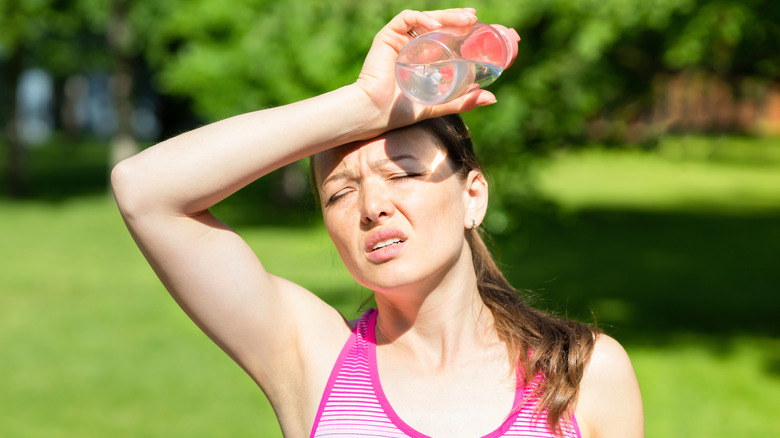How To Avoid Heat-Induced Headaches And Migraines
If you find your head hurting when spending time outdoors, particularly during warmer summer months, you may be experiencing a head-induced headache. As many as 10% of men and 20% of women experience heat-induced headaches or migraines that are hallmarked by a dull, throbbing pain in the back of the head or around the temples per Healthline. Luckily, there are many ways to both treat and prevent head-induced head pain, from holistic practices to medication. However, it's important to note that if you or someone else with a head-induced headache has a fever above 103.5 degrees Fahrenheit, exhibits slurred speech, or begins vomiting, emergency medical services should be sought.
The terminology used to describe heat-induced headaches and migraines might be confusing since heat itself doesn't cause these head conditions (via MedicalNewsToday). Instead, the heat simply provokes triggers that lead to painful headaches or migraines. Becoming knowledgeable about what can trigger a head-induced headache or migraine is the best place to start when it comes to avoiding them. Here's what you should know about identifying, treating, and preventing heat-induced headaches and migraines.
Recognizing and assuaging triggers
Heat-induced headaches and migraines can be exacerbated during warmer weather and hot temperatures, but there are multiple triggers that can set off a painful headache or migraine, per MedicalNewsToday. Dehydration and heat-related illnesses, such as heat exhaustion or heat stroke, can result in a heat-induced headache or migraine as a side effect. Other triggers include excessive exposure to sunlight, heat exposure following a missed meal or skipped medication, and engaging in exercise or intense physical activity in the heat.
According to Baylor College of Medicine, heat may be a trigger for the onset of a migraine for someone who is already prone to experiencing migraines. To prevent triggering a migraine, recommendations include drinking lots of water before, during, and after you spend time outside, and taking regular breaks from outdoor activity. Other treatment methods for heat-induced headaches or migraines encompass holistic methods and medication-based options (via Healthline). At-home remedies to treat heat-induced headaches or migraines include using essential oils, like peppermint and lavender to relax, applying a cold compress to your forehead, and drinking cold or iced herbal tea. Over-the-counter medications like acetaminophen, otherwise known as Tylenol, and ibuprofen can ease the pain of a headache or migraine. In addition to drinking lots of water for prevention of heat-induced headaches or migraines, try to incorporate electrolytes by having sports drinks when temperatures rise or you know you'll be spending a lot of time outside in the sun.


